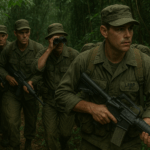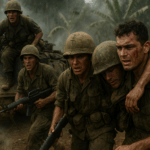It always starts the same way.
Someone says, “Hey, weren’t those LRRP guys in ‘Nam the same as MACV-SOG?”
And that’s when I usually lean in, smile, and say, “Not unless you think NASCAR and Formula One are the same because they both drive fast.”
See, the Long Range Reconnaissance Patrols, LRRPs, and the men of MACV-SOG did share some DNA. Both were small units. Both thrived on stealth. Both disappeared into the jungle for days at a time, relying on their wits, their rifles, and a radio with a prayer. But the similarities pretty much end there.
Let me walk you through it.
The LRRPs: Eyes in the Bush

Imagine a five-man team stepping off a Huey somewhere in the Central Highlands. They’re lean, silent, carrying light rucks, enough water to get in and out, and weapons built for speed: CAR-15s, maybe an M79 blooper, a radio, and a whole lot of guts.
Their job? Sneak deep into enemy territory, spot enemy troop movements, call in artillery or airstrikes, and disappear before anyone knew they were there. Sometimes they ambushed patrols. Sometimes they just watched. But mostly, they were ghosts — information gatherers for their division commander back at the fire base.
LRRP teams were attached to U.S. Army divisions, 101st Airborne, 4th Infantry, 1st Cavalry, you name it. They played chess for their generals, providing eyes miles beyond the line of contact. Their war was local. Silent. Intimate. A single snapped twig could mean a firefight that no one walks away from.
In 1969, many of these teams were folded into the newly formed 75th Infantry (Ranger) companies. New name, same deadly game.
MACV-SOG: War in the Shadows

Then there’s MACV-SOG, which, despite sounding like a department that files your payroll paperwork, was anything but.
Military Assistance Command, Vietnam – Studies and Observations Group.
Sounds dull. Like guys sitting around writing memos.
It wasn’t.
MACV-SOG was a CIA-sponsored, Pentagon-backed black-ops task force that specialized in the war outside the war. Their missions weren’t just classified. They were denied. If you got caught — and that happened a lot, Uncle Sam would pretend he didn’t know you. You didn’t exist.
Their AO? Laos, Cambodia, North Vietnam. Places where the U.S. officially wasn’t fighting.
These guys ran deep penetration missions behind enemy lines. Sabotage, snatching POWs, wiretaps, psychological warfare, assassinations. If LRRPs were recon, SOG was recon with teeth. With explosives. With a little voice in their ear saying, “If things go bad, we can’t come for you.”
SOG teams usually ran with 12 men: three Americans (usually Special Forces) and nine indigenous soldiers, Montagnards, Nungs, or Cambodians. The local guys knew the terrain, the trails, and the languages. And they fought like hell.
These teams carried gear you didn’t see anywhere else. Suppressed Swedish Ks. Sawed-off shotguns. CIA-issued sterile fatigues. No dog tags. No ID. Just guts and guns and a call sign like “Spike Team Idaho.”
Same Jungle, Different Wars

LRRPs were precision scouts for the divisions slugging it out across Vietnam’s hills and paddies. SOG? They were saboteurs, agents of chaos, knives in the dark aimed at the very spine of the North Vietnamese war machine.
LRRPs had a tough time. SOG had a death wish.
Bounties were placed on SOG operators, serious money, months of pay, for any NVA soldier who could bring in an American alive. Alive. Because that way, they could really find out what you knew. No pressure.
If you ever heard of the “One-Zero Club,” that’s SOG lingo, the team leader was the “One-Zero.” Those guys had a life expectancy you could count in dog years. Some lived. Most didn’t. All of them were legends.
The Breakdown
Here’s the gut-check difference:
| LRRP | MACV-SOG | |
|---|---|---|
| Purpose | Tactical recon for Army divisions | Strategic black ops and sabotage |
| AO | South Vietnam (sometimes near borders) | Laos, Cambodia, North Vietnam |
| Team Makeup | 5–6 U.S. soldiers | 3 Americans + 9 indigenous troops |
| Command | Army division S-2 | Pentagon / CIA through MACV |
| Secrecy | Official, logged | Denied, black ops |
| Gear | Light kit, standard Army weapons | Exotic guns, suppressed gear, no ID |
| Tactics | Stealth, intel gathering | Deep recon, sabotage, demolition |
| Risk Level | High | Insanely high |
So, Who Were the Badasses?
Both.
The LRRPs were the kind of guys who could sit in a spider hole for 48 hours watching a trail without moving. Who carried the weight of knowing a single wrong move could light up a whole division.
MACV-SOG guys? They stepped across the border into a war no one admitted existed. No support. No reinforcements. No rescue.
Both groups walked a line between life and death, silence and gunfire, mission and madness. The difference was mostly in how far they went, and how alone they really were.
So, next time someone asks you the difference between LRRP and MACV-SOG, you know what to say: “The LRRPs played chess. SOG? SOG flipped the table.”





Really fantastic visual appeal on this web site, I’d value it 10 10.
Thanks for this post, I am a big fan of this website would like to proceed updated.